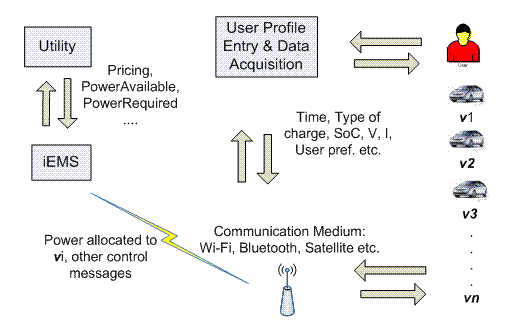
There is a need to address potential problems due to the emergence of technologies that will affect the utility industry in a time horizon of less than 20 years. One such technology is the plug-in hybrid electric vehicle (PHEV); the emergence of these vehicles in the marketplace poses a potential threat to the existing power grid. With a large number of these vehicles ‘plugged-in’ for charging, in the absence of control over the power drawn, the additional load can result in grid instabilities and disruptions. As a solution to alleviate such a situation and to allow for smooth integration of PHEVs into the grid, an “intelligent energy management system” (iEMS) is proposed in this project. The iEMS intelligently allocates power to the vehicle battery chargers through real time monitoring and control, to ensure optimal usage of available power, charging time and grid stability. This project is in collaboration with the FREEDM Systems Center and the Advanced Transporation Energy Center, NCSU, Raleigh.
Theoretical Focus:
The research work in this project aims to provide the conceptualization of the system architecture and the definition of its components, their attributes and interactions for enabling PHEV integration. The theoretical system description is implemented on a simulation test-bed for simulating myriad real world scenarios. Work is also ongoing to provide a mathematical framework for developing the iEMS algorithm for the optimal power allocation strategy under utility power constraints; taking into consideration the vehicle battery parameters and user preferences.
Demonstration Focus:
The system performance will be validated in a real world deployment with the implementation of the iEMS algorithm using actual vehicle batteries and in the presence of an enabling communication network. As a beginning step towards this, an experimental setup consisting of a Labview based GUI (with iEMS code) has been developed. The GUI monitors simulated batteries in ZigBee communication nodes and controls the charging process via wireless communication.

